Exhibit (c)(2) to
Schedule 13E-3
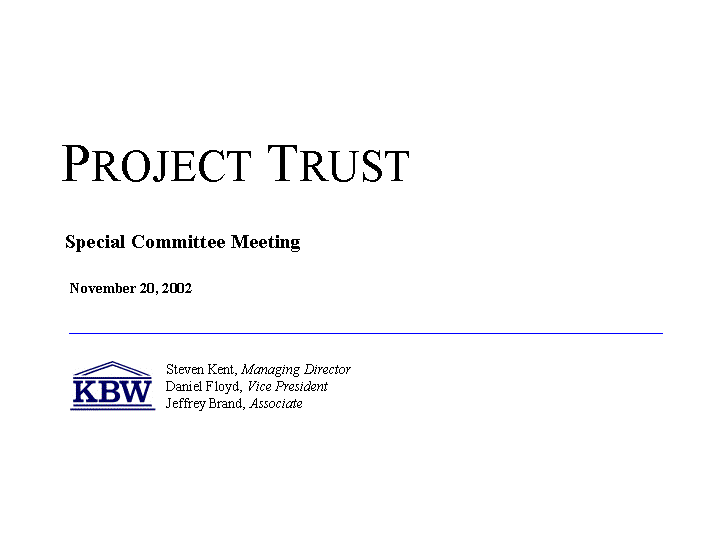
| Special Committee Meeting November 20, 2002 Steven Kent, Managing Director Daniel Floyd, Vice President Jeffrey Brand, Associate PROJECT TRUST |

| To achieve private company status via a "going private" transaction Resulting in: A reduction in the number of shareholders of record to fewer than 300 Deregistration of the Company's common stock under the federal securities laws Likely ceasing of NASDAQ OTCBB quotation of the Company's common stock Leading to: An enhancement of the Company's operational flexibility by permitting it to focus on long-term business strategies that are designed to fulfill the needs of its stakeholders (shareholders, customers, employees and communities) Objectives of Proposed Transaction |
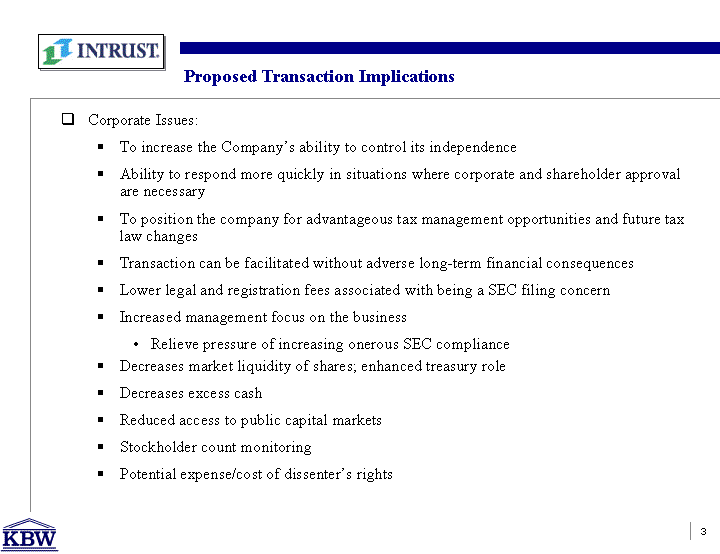
| Corporate Issues: To increase the Company's ability to control its independence Ability to respond more quickly in situations where corporate and shareholder approval are necessary To position the company for advantageous tax management opportunities and future tax law changes Transaction can be facilitated without adverse long-term financial consequences Lower legal and registration fees associated with being a SEC filing concern Increased management focus on the business Relieve pressure of increasing onerous SEC compliance Decreases market liquidity of shares; enhanced treasury role Decreases excess cash Reduced access to public capital markets Stockholder count monitoring Potential expense/cost of dissenter's rights Proposed Transaction Implications |

| Shareholder Issues Offers liquidity to small shareholders Alleviates existing and emerging risks and realities of Company share ownership Small market capitalization & public float Low trading volume The Company has no near term plans to issue additional shares to public Lack of available information due to ceasing to file periodic reports with SEC post transaction Lack of research coverage Lack of market making support Proposed Transaction Implications |

| Four possible structures to achieve objectives: Traditional share repurchase in the open market (Voluntary) Board approves and publicly announce. Conclusion: Less efficient use of capital and unlikely that the Company could acquire entire holdings from enough shareholders to achieve stated objectives Self tender offer (Voluntary) Company makes an offer to all its shareholders to purchase a specified number of shares of stock within a specified price range per share or a fixed price. Odd-lot tenders are self tenders specifically targeting shareholders with fewer than 100 shares. Conclusion: Less efficient use of capital and very low degree of success if large shareholders tender and pro-ration of tendered shares is necessary. Odd-lot tender cannot exceed holders of 100 shares, and even if it is assumed all the Company's odd-lots tendered, this would still not achieve stated goals. Going Private Structure Selection |

| Four possible structures to achieve objectives (continued): Reverse stock split (Involuntary) Company decides that x number of shares is now equal to 1 share and any fractional shares are cashed out. Conclusion: Less efficient use of capital because it would result in more fractional shares that would have to be cashed out. No dissenter's rights which could possibly increase chances of litigation from shareholders who did not want to be cashed out. Cash-Out Merger (Involuntary) Shareholders owning fewer than 1,XXX shares will be cashed-out in a reorganization transaction accomplished by the merger of a newly formed subsidiary of the Company with and into the Company Conclusion: Most efficient use of capital by pinpointing targeted shareholders and assuring success. More time consuming than voluntary methods due to required shareholder vote. Going Private Structure Selection |
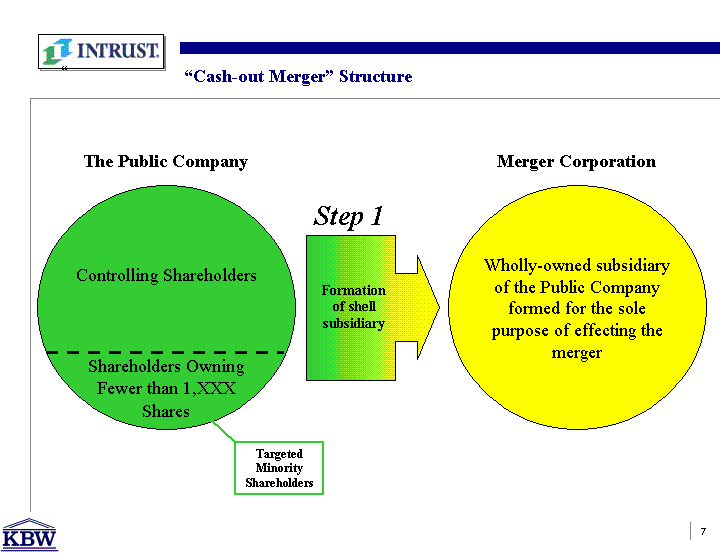
| " The Public Company Controlling Shareholders Merger Corporation Shareholders Owning Fewer than 1,XXX Shares Wholly-owned subsidiary of the Public Company formed for the sole purpose of effecting the merger Formation of shell subsidiary Step 1 Targeted Minority Shareholders "Cash-out Merger" Structure |

| The Public Company Merger Corporation is merged with and into the Public Company. The assets and property of the Public Company survive. Step 2 As a condition of the merger, shares owned by targeted shareholders are converted to cash, thus terminating their equity interest Shares owned by Public Company's controlling shareholders remain outstanding as shares of the company resulting from the merger with all rights, privileges and powers existing immediately before the reorganization. Merger Corporation shares are canceled without any action in the part of the holder thereof. "Cash-out Merger" Structure |

| Descriptions of necessary approvals: Shareholder vote Approval of non-employee directors or special board committee Bank regulatory approvals for merger and SEC approval of "going-private" disclosure to shareholder Transaction fairness KBW fairness opinion addressed to the independent committee, based on all information, that the consideration to be paid in the Transaction is fair, from a financial point of view, to shareholders of the Company, including both, those holders who will receive cash in the Transaction and those who will remain shareholders after the Transaction Discussion of all factors underlying the fairness opinion from a financial point of view Information relied upon No independent verification of information No independent appraisal of assets Description and disclosure of analysis and opinion provided by financial advisor "Cash-out Merger" Disclosure |

| Additional Detailed Disclosure Purpose of transaction and alternatives analyzed Effects on the Company and its affiliated and unaffiliated shareholders Cashed-out Unaffiliated and Affiliated shareholders Remaining Unaffiliated and Affiliated shareholders Potential conflicts of interests of Company executives and directors Different treatment for different shareholders (<[1,XXX]) Shares held by insiders: amount intended to vote for merger and disclosure of any recommendation to vote for or against the transaction Recent share transactions by the Company and insiders Audited financial statements required and certain pro forma financial analysis of the Company if material Appraisal rights of dissenting shareholders Management's financial projections "Cash-out Merger" Disclosure |
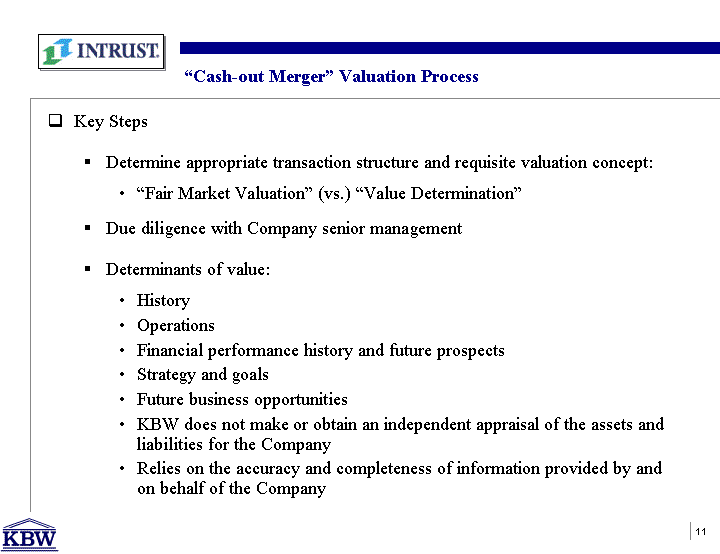
| Key Steps Determine appropriate transaction structure and requisite valuation concept: "Fair Market Valuation" (vs.) "Value Determination" Due diligence with Company senior management Determinants of value: History Operations Financial performance history and future prospects Strategy and goals Future business opportunities KBW does not make or obtain an independent appraisal of the assets and liabilities for the Company Relies on the accuracy and completeness of information provided by and on behalf of the Company "Cash-out Merger" Valuation Process |

| Valuation Concept -- "Not an Exact Science" Valuation driven: Fair Market Value Legally driven: Fair "Value" Market driven: Freely Tradable Value Valuation Test: -- "Entire Fairness Standard" "Cash-out Merger" Valuation Process |
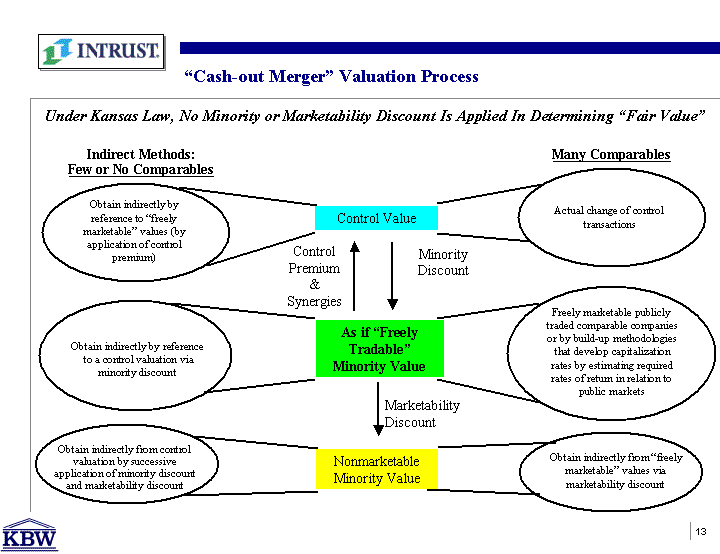
| As if "Freely Tradable" Minority Value Under Kansas Law, No Minority or Marketability Discount Is Applied In Determining "Fair Value" Control Value Marketability Discount Minority Discount Control Premium & Synergies Many Comparables Indirect Methods: Few or No Comparables Obtain indirectly by reference to a control valuation via minority discount Obtain indirectly from control valuation by successive application of minority discount and marketability discount Obtain indirectly by reference to "freely marketable" values (by application of control premium) Freely marketable publicly traded comparable companies or by build-up methodologies that develop capitalization rates by estimating required rates of return in relation to public markets Obtain indirectly from "freely marketable" values via marketability discount Actual change of control transactions Nonmarketable Minority Value "Cash-out Merger" Valuation Process |

| Control Value As if "Freely Tradable" Minority Value Nonmarketable Minority Value Enterprise Equity Value "Value" Range (Legal Concept) Fair Market Value Range (Financial Concept) Reflects lack of marketability discount from freely tradable value Reflects minority interest discount from enterprise / control value Reflects equity value of entire entity Reflects acquiror's synergies "Cash-out Merger" Valuation Process |

| Total Transaction Size Sensitivity Note: Table intended to show pricing sensitivity, not indicative of valuation outcome. "Cash-out Merger" Valuation Process |

| KBW will employ four primary methodologies in determining a valuation range for the Company's common stock: Comparable Public Company Market Analysis Comparable Merger and Acquisition Transaction Analysis Comparable Share Redemption Analysis Self-tender transactions (voluntary) Reverse stock split and cash-out mergers (involuntary) Going private transactions Discounted Cash Flows Analysis The Special Committee will select a level with the parameters of the valuation range at which to cash-out the targeted shareholders "Cash-out Merger" Valuation Process |
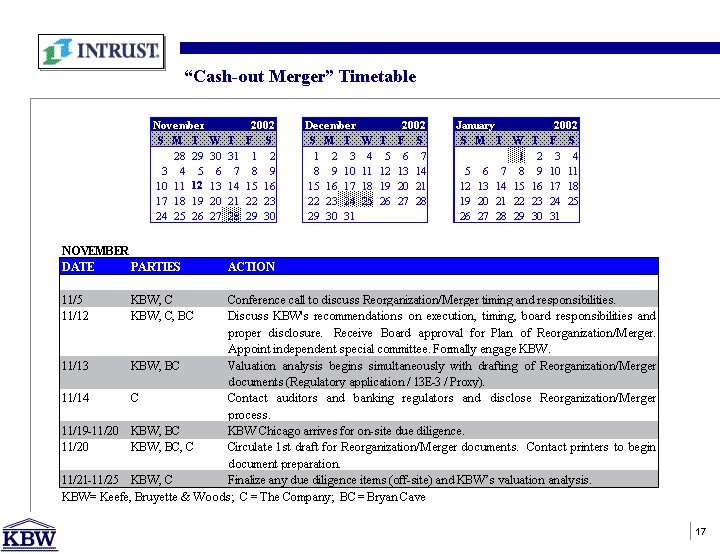
| "Cash-out Merger" Timetable |

| "Cash-out Merger" Timetable |

| "Cash-out Merger" Timetable |